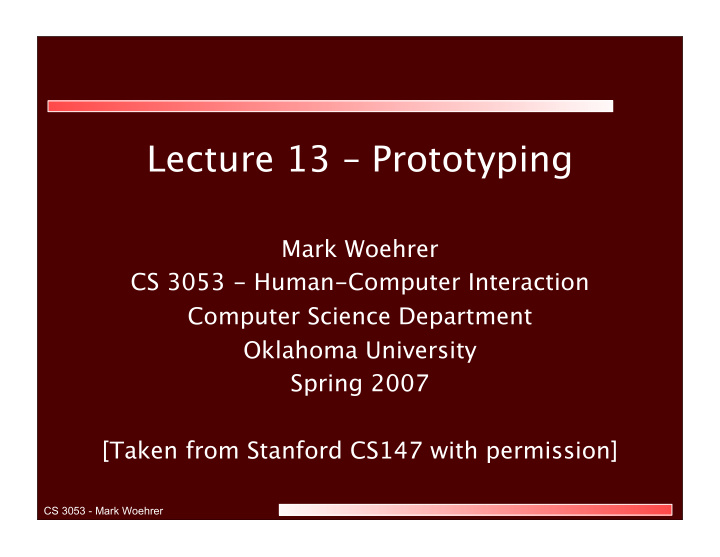



Lecture 13 – Prototyping Mark Woehrer CS 3053 - Human-Computer Interaction Computer Science Department Oklahoma University Spring 2007 [Taken from Stanford CS147 with permission] CS 3053 - Mark Woehrer
Learning Goals • Understand the uses of di fg erent types of prototypes for di fg erent kinds of designs and be able to choose appropriately • Know the basic techniques for low-fidelity prototyping • Be able to determine and apply the relevant techniques for your project CS 3053 - Mark Woehrer
What is a Prototype? • A representation of a design before the final artifacts exist • To evoke reactions from stakeholders in the design process – Designers – Users – Clients CS 3053 - Mark Woehrer
Uses of Prototypes • Design by doing – Clarify goals and requirements – “Reflective conversation with the materials” • Give users the experience of use – Look and feel • Test specific aspects – Compare alternatives – Make changes • Show feasibility for buy-in – Proof of concept – Manage expectations CS 3053 - Mark Woehrer
What to Prototype? “…Prototypes provide the means for examining design problems and evaluating solutions. Selecting the focus of a prototype is the art of identifying the most important open design questions.” Houde and Hill – What do Prototypes Prototype? CS 3053 - Mark Woehrer
Design Process UNDERSTAND OBSERVE IMPLEMENT VISUALIZE EVALUATE PROTOTYPE
Iterative Prototyping • Quality is a function of the number of iterations and refinements a design undergoes before it hits the street. • To get a good idea, get lots of ideas. • Enlightened trial and error is better than than the planning of a flawless intellect. CS 3053 - Mark Woehrer
FAIL EARLY (Cost of failure vs. project time curve) From Hans Haenlein, IDEO CS 3053 - Mark Woehrer
FAIL OFTEN (Risk vs. iteration curve) From Hans Haenlein, IDEO CS 3053 - Mark Woehrer
3 stages of prototyping # of ideas INSPIRE EVOLVE VALIDATE project time LOW RESOLUTION prototype driven specs → spec driven prototypes HIGH RESOLUTION From Hans Haenlein, IDEO CS 3053 - Mark Woehrer
Designing the Prototype • Choose what aspects to prototype for relevance to your project goals • Identify measurable design goals • Good enough to provide feedback but flexible enough for significant changes to be made down the line CS 3053 - Mark Woehrer
What can be a Prototype? • Sketches • Diagrams & Frameworks • Hand Made Constructions • Machined Constructions • Virtual Models • Graphics • Packaging • Spaces • Role Play, Experiences • Video • … CS 3053 - Mark Woehrer
Prototypes • Look like… • Work like… • Experience like ….. CS 3053 - Mark Woehrer
PROTOTYPE RAPID (IDEO “surgical tool”) CS 3053 - Mark Woehrer
Experience Prototyping Jane Fulton Suri - IDEO
From Greenbaum and Kyng, Design at Work 1991
Early Stage Prototypes •Low Fidelity (Paper) –Work with artifacts •Skits / Informance –Understand roles and context Focus on concepts, not detail Low investment in status quo Openness to change CS 3053 - Mark Woehrer
Storyboards CS 3053 - Mark Woehrer
Paper Prototype http://www.mindspring.com/~bryce_g/projects/lo_fi.html CS 3053 - Mark Woehrer
Low-Fidelity Prototype http://bmrc.berkeley.edu/courseware/cs160/fall99/projects/t4/body/low-fi/ CS 3053 - Mark Woehrer
CS 3053 - Mark Woehrer
CS 3053 - Mark Woehrer
Flipbook CS 3053 - Mark Woehrer
Flipbook CS 3053 - Mark Woehrer
Flow Diagrams From a previous cs147 project… CS 3053 - Mark Woehrer
Be Clever About Faking It • Device Mockups – Palm, Utopia,.. • Device substitution – PC prototype for small device – Tethers for wireless – Pager for defibrillator – … • Wizard of Oz techniques CS 3053 - Mark Woehrer
Wizard of Oz • Some aspects of interface are implemented • Operation requires processing that is actually done by a human, not directly visible to the user • The “wizard” intervention needs to be designed to be believable, both technologically and to the user CS 3053 - Mark Woehrer
Wizard of Oz for Multimedia Design (Oviatt) CS 3053 - Mark Woehrer
Fidelity is a Spectrum •Medium fidelity –Cleaned up but not decorated –Wireframes, Blocks, Greeking, … CS 3053 - Mark Woehrer
Medium Fidelity Prototypes
CS 3053 - Mark Woehrer
High Fidelity Tools • Web – FrontPage, GoLive, Dreamweaver,… • Screen mockups – Illustrator, Photoshop, PowerPoint,…. • Clickthroughs – Flash, PowerPoint,… • Graphic interface builders – Visual Basic, Visual C#, … – Smalltalk, Lisp,… – Flash, Director,… • Graphic toolkits – Java JFC/Swing, TCL/TK, Prefuse,… CS 3053 - Mark Woehrer
Breadth vs. Depth •Horizontal Prototype –Top level –Basic features •Vertical Prototype –Path in depth –Click-through or interactive •Combinations CS 3053 - Mark Woehrer
Web prototypes (Van Duyne) •Industrial strength methods •Artifacts –Site maps –Storyboards –Schematics CS 3053 - Mark Woehrer
Recommend
More recommend